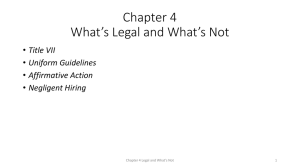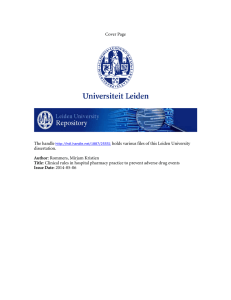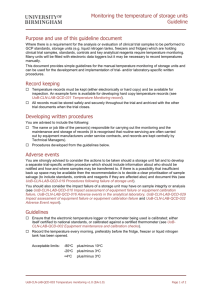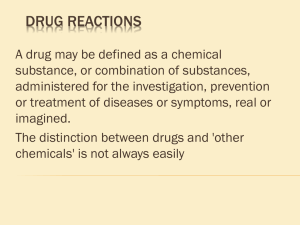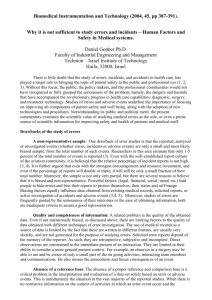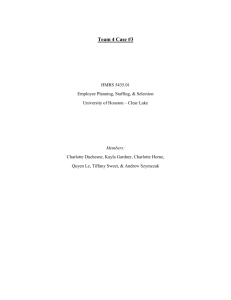File - One Direction
advertisement
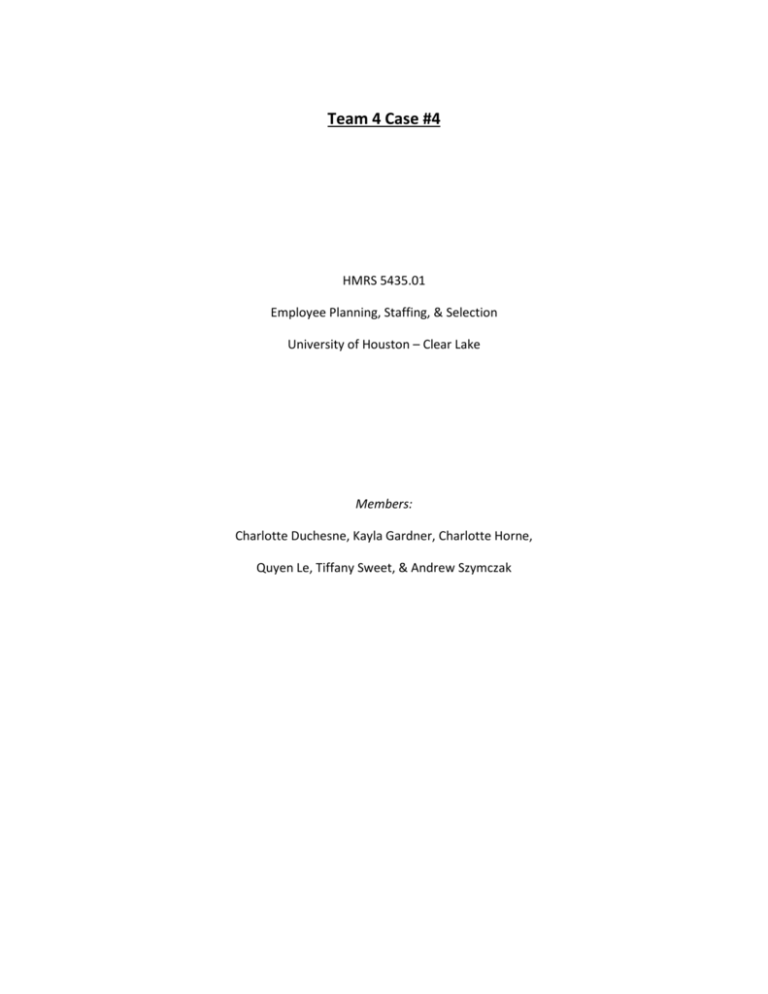
Team 4 Case #4 HMRS 5435.01 Employee Planning, Staffing, & Selection University of Houston – Clear Lake Members: Charlotte Duchesne, Kayla Gardner, Charlotte Horne, Quyen Le, Tiffany Sweet, & Andrew Szymczak HMRS 5435.01 Spring 2013, Group 4 Members: C. Duchesne, K. Gardner, C. Horne, Q. Le, T. Sweet, A. Szymczak 1. Is there any evidence of adverse impact against any race, sex, or ethnic groups? The four-fifths rule or 80% rule is the simplest and most common way of estimating adverse impact. The four-fifths rule is calculated first by finding the selection rate for each protected group (women and minorities), which is equal to the total number of applicants within the group that are hired divided by the total number of applicants within that group. Women= 12/35=0.3429, Blacks= 8/36=0.2222, Hispanics= 40/102=0.3922. The selection rate of Men= 148/385= 0.3844 and Whites= 112/282= 0.3972. The highest selection rate is Whites (0.3972). The impact ratio is found by dividing the highest selection (0.3972) rate by each group’s selection rate. The impact ratio of Women= 0.8633, Blacks=0.5594, Hispanics= 0.9874. According to the four-fifths rule, any impact ratio less than 0.8 is a four-fifths rule violation, therefore, there is evidence of adverse impact against Blacks whose impact ratio, 0.5594, is significantly less than 0.8. 2. If the total selection process for a job has no adverse impact, should the individual components of the selection process be evaluated for adverse impact? We find that in section 4C of the Uniform Guidelines on Employee Selection Procedures, the rule follows that “If information shows that the total selection process does not have an adverse impact, the Federal enforcement agencies, in the exercise of their administrative and prosecutorial discretion, in usual circumstances, will not expect a user to evaluate the individual components for adverse impact…” However, this section goes on to state that individual components should be evaluated for adverse impact: (1) where the selection procedure is a significant factor in the continuation of patterns of assignments of incumbent employees caused by prior discriminatory employment practices, and/or (2) where the weight of court decisions or administrative interpretations hold that a specific procedure (such as height or weight requirements or no-arrest records) is not job related in the same or similar circumstances (uniformguidelines.com). Although Uniform Guidelines are given “great weight” in many selection court cases, they are not the last word. They are merely a reference for the judge and jury to make a verdict; the ultimate decision rests on the court alone. By identifying job-related KSAOs (knowledge, skills, abilities, and other characteristics), developing selection procedures to assess these KSAOs, and validating these procedures, Santa and Burden are taking the appropriate steps to defend their multiple-hurdle selection process in the event that they should need to. HMRS 5435.01 Spring 2013, Group 4 Members: C. Duchesne, K. Gardner, C. Horne, Q. Le, T. Sweet, A. Szymczak 3. Which type of validation would you use? Why? What are the differences between content and criterion validity studies? For this situation, we would use a content validation study because it provides an assessment of the selection measure and the job content relevance. It also is the kind of study that should be used when a comprehensive job analysis is available or feasible. The KSAOs derived from the Task/Behavior inventory (Exhibit 2.15) cover a broad base of data that were objectively chosen by subject matter expert incumbents and supervisors using a critical incident technique. It is reasonable to assert that the KSAOs chosen are generally accepted KSAs. Content validation studies “have wide applicability in the selection individuals for jobs requiring generally accepted KSAs” (Gatewood, 151). We would also choose this method because these studies focus on job content and the linkage of job tasks to important KSAs. Additionally, the results of these studies can help increase the perception of fairness among applicants. Content and criterion-related validation studies differ because content studies focus on broad, more judgmental descriptors and they focus on the selection measure itself. Criterion studies focus on an external variable, they are based on a specific set of defined data, and they are nested with precise quantitative indicators. They are also sometimes referred to as the present employee studies because the information is collected for a current group of workers (Gatewood, 159). 4. Evaluate the job analysis procedures used in this case. Is it necessary to do such a thorough analysis? Yes, it is recommended that a thorough analysis is completed. Job analysis phase is a critical step in determining if there was adverse impact. Job analysis will determine if the testing and interviewing process is relevant and is related to the job, which will prevent discrimination. The critical-incident technique used by Ron is important to determine what the critical roles are and what would be considered successful and unsuccessful. This will be used to better analyze potential candidates to select the best candidate based on the findings. The findings during a thorough job analysis will be used in court if an adverse impact lawsuit would arise. This phase will help determine the KSAO’s the job entails and will help structure the interview phase, testing phase and training. You can look at it as the foundation for the steps following. This can be used to identify, test, and measure the effectiveness of training. This can also be used in compensation and determine compensable job factors. The job HMRS 5435.01 Spring 2013, Group 4 Members: C. Duchesne, K. Gardner, C. Horne, Q. Le, T. Sweet, A. Szymczak analysis will also help structure the interview process so all potential candidates are treated fairly and interviewed the same, to prevent any form of potential adverse impact. 5. If you are doing a criterion-related validity study, should your criterion be success in training or onthe-job performance? In this case, the criterion-related validation study should be on the job performance vs. success in training. Criterion-related validation is narrowly based on a specific set of data… and to utilize it properly, there must be a large sample size (Gatewood, 155). In this case there are over 300 employees therefore the sample size is large enough to use a criterion-related validation. Ron knew he had to keep the interviews somewhat the same since other subordinates also wanted that and he knew that he had to come up with a way to prohibit discrimination in the interview process. In the case it states that although there was a task inventory the major tasks or job duties had not been rated for importance, difficulty, frequency or trainability and since this is a federal government agency, training is essential to their success and handling situations outside of everyday norms. Conducting a job analysis is the first thing Ron should do in a criterion-related validation study with on the job training. In the case it states that there were no written rules that specified how to best do the job, therefore Ron asked a sample of agents to develop three critical incidents and to indicate the task associated with each incident. He then asked them to rate a level of importance and behaviors that were associated with these incidents and report the amount of training that was required for each. By doing this, it attempts to outline the actual tasks that are required and actually performed on the job. After creating this job analysis, Ron proposed a reading comprehensive exam that would include incidents and laws pertaining to each incident that he would have applicants fill out. For this federal government agency using the on the job performance for the criterion-related validity would be best because it most accurately describes real life situations. Many times training is way different than the actual job or certain situation ends up being. It is important to have the knowledge and skills that are required of a person when they are being placed in real life situations versus training facilities with structured agendas.


